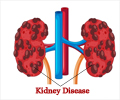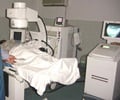Scientists have found that infusing just a small dose of a cytokine, thought to help cause that failure, can prevent or reverse kidney failure.

‘The cytokine IL-17A has long been considered a classic promoter of inflammation. But a new study found that infusing just a small dose of the cytokine can prevent or reverse kidney failure.’





His lab was pursuing its role in kidney damage but found that when they deleted the IL-17 gene in mice, then induced diabetes, it resulted in increased kidney injury, Ramesh said. They looked next at patients with severe diabetic nephropathy, and found levels of IL-17A reduced in their blood and urine. In follow-up studies in animal models of both type 1 and type 2 diabetes, IL-17A's surprising role grew: When researchers infused a small amount of IL-17A every 48 hours for several weeks, it prevented or reversed diabetic nephropathy in their diabetes models. In fact, the therapy worked best in late-stage diabetic nephropathy, Ramesh said. IL-17A therapy also reduced high levels of fat in the blood, a hallmark of type 2 diabetes that is believed to contribute to related kidney and cardiovascular problems.
"It clearly indicates that IL-17A is protective," Ramesh said. "It does well for the kidney in suppressing damage in response to diabetes." Ramesh is corresponding author of the study, published in the Journal of the American Society of Nephrology, which is the first to look at IL-17's role in chronic kidney disease.
IL-17A seems to protect kidney cells multiple ways, including inducing the anti-inflammatory molecule AMWAP, or activated microglia/macrophage WAP domain protein. The cytokine also appeared to aid survival and regeneration of key kidney cells, including podocytes and epithelial cells in the tubules. Podocytes help the kidney retain important large molecules such as protein, and epithelial cells line tubules where these essentials are reabsorbed.
To date, the MCG research team has seen no ill effects from overexpressing IL-17A in mice kidneys and to some extent in their circulation. Currently, there are no drugs available to increase patients' IL-17A levels, but there are inhibitors for the cytokine that is considered causative in autoimmune diseases such as Crohn's. Emerging laboratory and clinical trial data indicate there may need to be drugs that do both.
Advertisement
The MCG researchers note that whether IL-17 promotes or suppresses inflammation may be related to the level and length of time it's stimulated. Response may also depend on which of the six different forms of IL-17 is activated, the receptors activated and resulting downstream signaling. In their studies, for example, increasing IL-17C and IL-17E levels did not have the same positive effect on diabetic nephropathy as IL-17A as well as IL-17F.
Advertisement
A primary way physicians check kidney function is looking for signs of patients excreting the protein albumin in their urine. Albumin, which is made by the liver, is a major protein in the blood that helps keep blood from leaking out of blood vessels and helps keep other vital substances such as nutrients and hormones in the blood. Well-functioning kidneys retain albumin, and, even on dialysis, patients with diabetic nephropathy secrete a lot of protein in their urine.
The annual cost of diabetic nephropathy in the United States is estimated at more than $20 billion.
Source-Eurekalert















